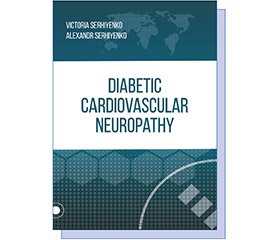Международный эндокринологический журнал Том 14, №2, 2018
Вернуться к номеру
Review of the monograph “Diabetic cardiovascular neuropathy”
Авторы: Victoria Serhiyenko, Alexandr Serhiyenko
Рубрики: Эндокринология
Разделы: Справочник специалиста
Версия для печати
Stavropol: Logos Publisher; 2018. 110 p., UDK 616.379-008.64.
BBK 54.15. ISBN 978-5-905519-86-4. DOI:10.18411/dia012018.49
BBK 54.15. ISBN 978-5-905519-86-4. DOI:10.18411/dia012018.49
Cardiovascular autonomic neuropathy (CAN) is a serious complication of diabetes mellitus (DM) that is strongly associated with approximately five-fold increased risk of cardiovascular mortality. CAN manifests in a spectrum of things, ranging from resting tachycardia and fixed heart rate to the development of silent myocardial infarction. Clinical correlates or risk markers for CAN are age, DM duration, glycemic control, hypertension, and dyslipidemia, development of other microvascular complications. Established risk factors for CAN are poor glycemic control in type 1 DM and a combination of hypertension, dyslipidemia, obesity, and unsatisfactory glycemic control in type 2 DM. Symptomatic manifestations of CAN include sinus tachycardia, exercise intolerance, orthostatic hypotension, abnormal blood pressure regulation, dizziness, presyncope and syncope, intraoperative cardiovascular instability, asymptomatic myocardial ischemia and infarction. Methods of CAN assessment in clinical practice include evaluation of symptoms and signs, cardiovascular reflex tests based on heart rate and blood pressure, short-term electrocardiography, QT interval prolongation, heart rate variability (24-h, classic 24-h Holter electrocardiography), ambulatory blood pressure monitoring, heart rate turbulence, baroreflex sensitivity, muscle sympathetic nerve activity, catecholamine assessment and cardiovascular sympathetic tests, cardiac sympathetic imaging. Although it is common complication, the significance of CAN has not been fully appreciated, and there are no unified treatment algorithms for today. Treatment is based on early diagnosis, life style changes, optimization of glycemic control and management of cardiovascular risk factors. Pathogenetic treatment of CAN includes: balanced diet and physical activity; optimization of glycemic control; treatment of dyslipidemia; admi–nistration of antioxidants, first of all α-lipoic acid, aldose reductase inhibitors, acetyl-L-carnitine; vitamins, first of all fat-soluble vitamin B1; correction of vascular endothelial dysfunction; prevention and treatment of thrombosis; in severe cases — treatment of orthostatic hypotension. The promising methods include prescription of prostacyclin analogs, thromboxane A2 blockers and drugs that contribute to strengthening and/or normalization of Na+, K+-ATPase (phosphodiesterase inhibitor), α-lipoic acid, dihomo-γ-linolenic acid, ω-3 polyunsaturated fatty acids, and the simultaneous administration of α-lipoic acid, ω-3 polyunsaturated fatty acids and dihomo-γ-linolenic acid, but the future investigations are needed. Development of orthostatic hypotension is associated with severe or advanced CAN, and prescription of nonpharmacological and pharmacological treatment, first of all midodrine and fludrocortisone acetate, is necessary.
In general, this monograph will be very useful for endocrinologists, cardiologists, neuropathologists and family doctors.
Editor-in-Chief of the “International Journal
of Endocrinology”, Professor V.I. Pankiv
of Endocrinology”, Professor V.I. Pankiv

